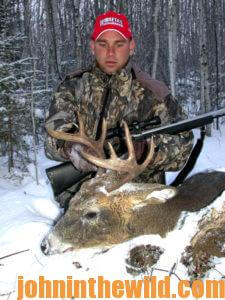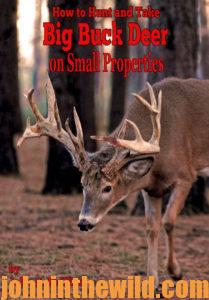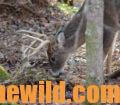Editor’s Note: Odd-ball tactics may sound funny – but they just may be the change-of-pace you need to put a buck on the meat pole. Deer are curious, and their natural curiosity is one of the most-overlooked aspects in most sportsmen’s hunt plans.
* Building a Fire – Reason dictates that deer will run from fire and view fire as an enemy. However, the Cree Indians of Manitoba, Canada, have used fires since recorded time to stay warm while  hunting and to lure deer and moose to within bow range. I first saw this deer lure used while hunting in the Interlake wilderness area of Manitoba, which embraced much of the land around Lake Manitoba and Lake Winnipeg. One of the guides recommended that some hunters from New York State build a fire, and that deer would come to the smoke, stand, look at the fire and present them with a shot.
hunting and to lure deer and moose to within bow range. I first saw this deer lure used while hunting in the Interlake wilderness area of Manitoba, which embraced much of the land around Lake Manitoba and Lake Winnipeg. One of the guides recommended that some hunters from New York State build a fire, and that deer would come to the smoke, stand, look at the fire and present them with a shot.
Anthony Messina, one of the hunters, said emphatically that, “In New York, if a deer saw or smelled smoke, it would leave the country. I never heard of building a fire to lure in a deer, and I’m never going to do that.” But on the last day of his deer hunt, he and his brother Zack decided to build a small fire inside their ground blind and test this technique. When the Messinas returned to camp, I’d never met men more excited about a deer-hunting tactic.
Anthony told me, “We snapped off some dried tree limbs, built a small fire and piled up a cache of dried limbs to feed the fire. On this last day our hunt, I’d already tagged-out, although Zack hadn’t.” About an hour after daylight, the Messina brothers spotted a huge 12-point buck, weighing over 300 pounds, following the smoke from the fire straight to them. Anthony remembers, “I believe the buck coming to us would have scored between 180 and 200 points on Boone & Crockett.” Then the buck stared at the flickering fire that he partially could see behind the ground blind. But Zack’s rifle wouldn’t fire. The buck slowly walked away without being spooked, allowing Zack to reload and finally take him.
* Making the Fawn-in-Distress Call – Outdoorsmen have learned that the fawn-in-distress call is one of the most-successful deer calls to use to bring in deer in the early season, particularly during bow season when the does still may have fawns with them. When a doe thinks a predator is trying to kill her young fawn, she’ll come running to rescue it. To call in an adult doe, you can use other calls like a rabbit squealer or any other type of predator call that sounds like a young animal’s bawling and screaming. If you need to harvest does off your property to keep your herd in balance, use these fawn-in-distress or rabbit-in-distress calls to bring in big does.
* Taking Does – Many deer hunters and biologists think there’s no more effective way to call in a buck than to shoot a doe first. Some estimate that up to 25 percent of  the time that a hunter harvests a doe before he takes a buck, mature bucks will come to investigate. Be sure not to leave any human scent when going to your tree stand. Then don’t get out of your tree stand after you’ve shot the doe – often some hunters remain in their stands for two hours. The bucks seem to be drawn in by the smell of a dead doe, even if she’s not in heat.
the time that a hunter harvests a doe before he takes a buck, mature bucks will come to investigate. Be sure not to leave any human scent when going to your tree stand. Then don’t get out of your tree stand after you’ve shot the doe – often some hunters remain in their stands for two hours. The bucks seem to be drawn in by the smell of a dead doe, even if she’s not in heat.
* Luring with a Tree Stand – Other hunters swear that putting-up tree stands can lure in deer. For example, when your tree stand bangs against a tree, you’re breaking limbs and shaking leaves. You’re often grunting and moaning from the exertion of putting up the stand too. From a distance, you may sound like a buck fight to a deer.
* Painting Your Tree Stand Ladder White – A friend of mine once told me that his favorite tree stand made of wood needed to be painted to protect it from the weather. With white paint on hand left over from painting a room, he painted his tree stand’s ladder white. Two days later, he returned to that stand and harvested a nice buck that was staring at the white ladder and cautiously walking to it. When he mentioned the white ladder  seeming to attract a buck to a wildlife biologist later, the biologist answered, “I’m not surprised. White-tailed deer are very curious, and anything that’s different in their environment will attract their attention.”
seeming to attract a buck to a wildlife biologist later, the biologist answered, “I’m not surprised. White-tailed deer are very curious, and anything that’s different in their environment will attract their attention.”
* Flagging – Western hunters lure in antelope by flagging, and some deer hunters say this tactic lures in deer too, especially if the deer are out of range. Outdoorsmen like to use this tactic when deer are out in a field with big, round bales of hay in it where they can hide behind and watch.
If a herd of deer is at the other end of a field from you, try to identify the lead doe. Make sure she’s not looking your way when you flag her. Stick your hand out from the side of the bale of hay where you’re hiding. Move it up and down quickly a couple of times to get the doe’s attention, before pulling your hand back behind the bale of hay. She may think she’s seen a deer’s tail out of her peripheral vision, or that action even may spook her. But you may be able to call deer to within 25 yards of you with this method.
To learn more about hunting deer, check out John E. Phillips’ book, “How to Hunt and Take Big Buck Deer on Small Properties,” available in Kindle, print and Audible versions at (http://amzn.to/1vIcj4m).
Tomorrow: Understand How to Cope with Hunting Pressure









